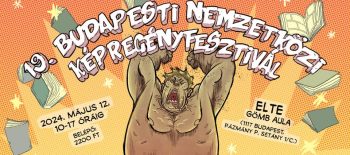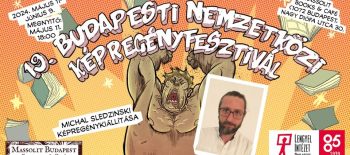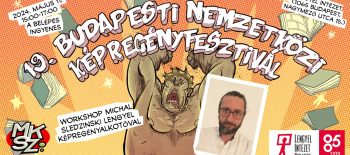Kiállítás látogatható május 12-tól juniús 23-ig
Łukasz Pastuszka (lengyel építész – Moomoo Architects) és Illés Zsófia Szonja (magyar képzőművész – Collective Plant) interaktív installációi a közösséggel és közösségi alkotás folyamatával foglalkoznak. A két látszólag különböző területről és kultúrából érkező alkotó a fenntartható design és étkezési kultúra közösségi aspektusainak fókuszában találta meg az alkotásban a közös hangot. Munkáik az építészet, design, installáció, képzőművészet és gasztronómia határain tett izgalmas kísérletek, melyeknek elsődleges célja az alkotói és befogadói attitűdök és hagyományos szerepek, illetve a hagyományos galériatér átrendezése, újraértelmezése.
FOREST c. installációjuk fa elemekből, videóból, zajokból, ízekből, illatokból építkezve, a látogató aktív bevonásával, az érzékszervi megtapasztalásra építve (hallás, látás, tapintás, szaglás, ízlelés) hozza el egy belvárosi galleria terébe az erdő és a természet élményét. A hagyományosan vett galériatér átalakul, és a látogató a szemlélődő szerepéből az aktívan megtapasztaló résztvevő szerepébe kerül át, hiszen csak az ő interakciója által válik élővé és működővé az installáció.
A két alkotó korábban a 2015-ös Hello Wood Project Village-re készített food-installációt (Tea Totem)
Közremüködők / videó, zaj: Mladin Bence, Halász Dániel
Támogatók: Hello Wood, Technika, Pipacs Pékség
Az alkotók:
Illés Zsófia Szonja
www.zsofiasonia.com
www.collectiveplant.com
Łukasz Pastuszka
http://moomoo.pl/
———————————————————————————————
Bringing back the forest feeling
New project of Platan Gallery plays with wide range of associations related to woods, while all the hints lead to the interdisciplinary exposition prepared by Polish architect Łukasz Pastuszka and Hungarian photographer Zsófia Szonja Illés. This time successful duo works with nature experience and architectural settings to create a perfect scenery for human interactions. Their exhibition “Forest” combines the wood elements, videos, sounds, even forest food and aims to recall community making rituals.
Patrycja Rup: “Forest” is your sequent project after successful “Tea totem” created during last edition of Hello Wood. How did your collaboration begin?
Łukasz Pastuszka: We met thanks to amazing Hello Wood team and we have spent some time together on the camp and as well in Budapest, so this even is the next step and continuation of our cooperation. I love to work with Zsofi, cause she knows so much about food and plants, and that brings the architecture experiments to another level.
Zsófia Szonja Illés: The collaboration began during last year Hello Wood Project Village (2015). I work with food and sustainability projects (Collective Plant), and was invited to work with Łukasz at HW to develop together a sustainable marketplace idea. The Tea Totem plan originates from the idea of the smallest market unit of the world: one which is based on the interaction just between a vendor and a buyer plus a product (which in this case was the herbal tea, dried and prepared right there in the tower – a herb drying tower regarding its function).
PR: How the “Forest” project was born? What was the main source of inspiration for you?
Zs: Łukasz already had a “Forest in the city” plan for a while ago, and my Collective Plant project is just about the same issue, so it wasn’t hard to find a common subject for our exhibition.
Ł: I think although I am architect, we both with Zsofi like to experiment with things related to architecture, food, space, and we prefer that more than the very technical approach to architecture. We love spending time outside and as Hello Wood was always an amazing time during the year, we wanted to get similar feeling in the city.
PR: What are the most significant values for you as designers?
Zs: Simplicity, community, re+inter/action, message.
PR: Nowadays we can observe popularisation of ‘architecture and food’ activities, interdisciplinary projects exploring bounds between cuisine, design and architecture expand in London, Copenhagen, New York and Puerto Rico, just to name few locations. Do you think it has a potential to turn into the world-wide movement?
Zs: I do not think we should put anything in a box like that. I don’t believe it is a movement, or a popularised activity, I think it is just a very human need emerging and being realised recently (not just by artists or architects) – by the effects of our very impersonalised and online society: the need for community and personal interactions. And food can actually be a very pleasant channel for creating community (if you think about city community gardens etc.) Getting back to our roots on one hand, and turning it into some kind of arts in the other hand – in the creative activity meaning of it – it can really bring back the qualities of arts and creativity into our lives. The whole idea of my project (Collective Plant) started thanks to this personal motivation – I didn’t plan “to make arts”, or anything fancy, just wanted to make my own life better. This project is also much more about a community work, a community creating process – I have been enjoying it much more recently than creating alone and individually. I have been a lonely photographer, and haven’t enjoyed it that much anymore. I realised that what I really enjoyed, was creating in community (this is what we have in common with Lukasz), and creating interdisciplinary, because I believe it can have a great impact in any kind of work – even if it was about arts or architecture.
PR: Eating in the public sphere became a performative experience, fancy places serving food in Europe try to add narrations to meal consumption turning it in some cases into special celebration emphasized by the unique interior design. Do you find it as a manifestation of consumerism or rather as coming back to roots of tradition when meals had special symbolic and community-making values?
Zs: For me personally, it is more about getting back to our very basic human needs of being in community, as I mentioned, and creating (or just enjoying) something collectively created with our two bare hands. It is a kind of experience we do not get often in modern cities nowadays, but seems that we really need it.
PR: You create in the Platan Gallery an interactive and immersive zone recalling nature. Visitors are brought to the dreamy and relaxing forest experience, but the installation itself is highly technologically processed: prepared meals, processed wood and finally the imitative large scale screening. What is the main aim of this illusion? How would you like to involve the visitor?
Zs: We wanted to bring a piece of forest to the city which seems something so far from our cities nowadays. A piece of forest through experiencing it with our senses: touching, tasting, smelling, watching, and listening. We would like to create a forest oasis in the centre – at a very unusual location, where normally fine art pieces are exhibited, so it is something special also in this sense. Transforming a gallery space into something unusual. I have been exhibiting as a photographer for about 10 years now and started to find it boring due to lack of interactions: I have found it boring both as an artist and also as a visitor. What fascinates me most is interaction. My mind works this way: I can understand an art piece (or anything) much more if it is a kind of experience I can take part in (it is something like a good education should be). So the installation starts to work through being in interaction with the visitors: those who will actually taste it, touch it, transform it.
The food will not be really processed by the way: what I am going to prepare is just as natural and raw as it could be (wild food from our forests).
PR: As your project is highly sensorial, you are designers of the visitor’s experience. Temporary public meal events are strongly influencing social relations and help to initiate new interactions, while architecture creates the space for these activities. Would you call your project rather a social or an aesthetic experimentation?
ZS: It is both: needs social interaction (otherwise makes no sense), but the artistic/visual representation/design makes it work for the visitors.
Ł: It’s nice to have a chance to connect all those elements together, bring forest inside the city. And the fact that it happens in the art gallery is totally crazy.
Interview by: Patrycja Rup – Polish culture manager & journalist. Lives and works in Budapest.
ARTGUIDEEAST http://artguideeast.com/forest-platan-gallery-budapest.html
Samu Szemerey épitész, urbanista megnyitó beszéde:
Nagyrabecsült lakótársak, tiszteletre méltó nemzetségek, kedves erdei testvéreim!
Azért gyűltünk most össze, hogy ismét megemlékezzünk álmaink közös teréről. Azért vagyunk itt, hogy együtt lépjünk be a helyre, amit időtlen idők óta építünk a képzelet terhes munkájával. Együtt – hangsúlyozom, hiszen bár személyes erőfeszítések nélkül semmire sem jutnánk, de elő kell lépnünk a magány kényelméből, és meg kell osztanunk egymással a tudásunkat, hogy összeépülhessen a Mű. Hogy ősszeépülhessen, és hogy fennmaradhasson. Hogy elkerülhessük a bajt, mielőtt visszafordíthatatlanná válik. Nincs bennem kétség – nyilván tudjátok, hogy a városról beszélek. A város – vágyaink és emlékezetünk legfőbb tárgya. Mióta álmodjuk már, van-e bárki az állatok között, aki ne lenne részese, létrehozója? A város – közös alkotásunk, őseink képzeletében született, hogy azután számolatlan nemzetség álmai növesszék és terjesszék el szerte a lombok alatt. A város a közösségünk szebbik arca, a hely, ahol az ösztönök kényszereit levetve végre felszabadíthatjuk az érzékeinket, és az alkotás, a tiszta élmények, a tapasztalat teljességével gazdagíthatjuk egymást. A város a mi teremtményünk. És mégis, több ezer virágzás óta nézzük tétlenül, ahogy a városból kiszorultunk. Több ezer lombhullás óta szolgák módjára, pórázon, félszegen, szervezetlenül keressük a módját annak, ahogy a várost újra magunkévá tegyük. És mindeközben mi történik? Azt hallani, hogy az álmaink elbitorolt világát egyesek fákkal, sőt, erdőkkel “zöldítenék” ki! Sőt, mások azt mondják, hogy lombokkal, fenyőillattal, füvekkel kell “gazdagítani” a képzeletünket! Hogy “parkokban” lehet csak igazán élni! “Természetről” és “egyensúlyról” beszélnek – hát nézzetek körül, miféle természetet, miféle egyensúlyt láttok itt a lombok alatt? Ráadásul mindezt akkor, amikor végre eljutottunk oda, hogy teljesüljön a régi cél – hogy a városaink mindenütt jelen legyenek és mindennel összekapcsolódjanak. Nem várhatunk tovább. Eljött az idő, hogy visszafoglaljuk és megvédjük a legfontosabb értéket, amit örökségül kaptunk. Folytatnunk kell az építkezést. De előbb, az alapoknál kell kezdenünk. Vannak közöttünk, sajnos egyre többen, akik mára szinte elfelejtették a mámorító élményt, ami az első találkozás után csak egyre erősödik. Ezért jöttünk most itt össze, hogy felidézzük, megélhessük a várost, hogy az közös álom kivételes terét hozzuk létre.
Nézzetek körül, élesítsétek az érzékeiteket, és ne féljetek megmerítkezni az élményben.
Elfogyasztjuk a várost. Körbeszagoljuk a várost. Hozzádörgölőzünk a városhoz. Elmerülünk a város fényeiben. Azért vagyunk itt, hogy ezt megtapasztalhassuk. Felelősséggel tartozunk a város iránt. Legyetek bátrak, állhatatosak, ravaszak és figyelmesek. A beton legyen veletek.



